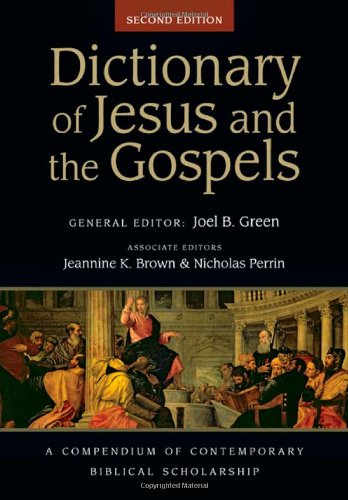 Dictionary of Jesus and the Gospels, 2nd ed., eds. Joel Green, Jeannine Brown, and Nicholas Perrin (IVP Academic, 2013). 1120 pp.
Dictionary of Jesus and the Gospels, 2nd ed., eds. Joel Green, Jeannine Brown, and Nicholas Perrin (IVP Academic, 2013). 1120 pp.
Imagine that you are about to preach on the Sermon on the Mount. You have no interest in form or redaction criticism; you don’t care about Q. But you are also aware of the benefits of studies that compare Matthew’s Sermon on the Mount with Luke’s Sermon on the Plain, and you realize critical literary studies can be helpful for understanding the Sermon as a whole. You have a couple options available: Carson has published a book with a 110-page exposition of the Sermon, but there is little discussion of the critical research; it focuses on expositing the text. On the other hand, there is the ICC commentary by Davies and Allison on Matthew 1-7, which would contain all the critical data you need, but would probably not be much help with expositing the text as a coherent message from Jesus (not to mention its enormous length).
Enter the Dictionary of Jesus and the Gospels (second edition). This work contains an entry that spans 10 large pages and summarizes the Sermon’s sociohistorical and literary context, gives some interpretive analysis, does the same for Luke’s Sermon on Plain, and concludes with a section on the historicity of the sermon. This dictionary would enable you to get a firm grasp on the critical issues involved in interpreting the Sermon and give you some literary and theological context with which to interpret it. At the end of the article is a large bibliography of further works to pursue.
Of course this is only one scenario. This semester I was teaching on the nature of the term “apostle” and its relationship to the Jewish Shaliaḥ concept. Schnabel notes a work that he believes proved that relationship to be anachronistic (although I’m skeptical, since there is some evidence of the concept in the Dead Sea Scrolls). Much to my chagrin, I must track down that work before I teach on “apostle” again. But I’m thankful that an overview essay such as Schnabel’s on “Apostle” pointed me to the various views of the subject and representative criticisms of those views (including the view that I taught).
Note that this is the second edition of the volume. It has proven to be of such great use since the first edition was published in 1992 that it was deemed worthy of revision. (In fact, I would at this point recommend all the IVP dictionaries; they have proven useful for me time and again to orient myself to new subjects with which I am less familiar). This is no small revision, however. About ninety percent of the original material has been replaced and most of the entries were assigned to new scholars. So this is truly an updated and completely re-written volume.
The dictionary spans about 1,000 pages. I have already noted its usefulness but let me mention one of its weaknesses. There is often a vacillation between presenting the primary evidence on a subject and presenting the history of scholarship. Some articles present mostly primary evidence with little interaction with academic literature; some do the opposite; some try to strike a balance between the two. Personally, I prefer the articles that present the primary evidence first and then briefly summarize what scholars have done with the evidence, mostly because you can’t really comprehend an entire monograph in a few sentences of summary, so I would rather gather the evidence and read monographs later.
However, some articles are necessarily oriented toward research history, such as “Form Criticism,” which looks at Gunkel, Dibelius, and Bultmann and evaluates them, as well as “Criteria of Authenticity,” which is related to historiography within Jesus studies. Bock’s essay on “Son of Man” is an example of an evidence-based article. He provides a summary analysis of the various kinds of “Son of Man” texts in various Gospels and in Second Temple Judaism, interacting minimally with secondary literature but providing enough to be oriented to various views and providing a lengthy bibliography.
The Dictionary of Jesus and the Gospels is and will remain for a while now a standard reference work on the Gospels. Pastors can benefit by reading through articles related to their sermons or to upcoming sermon series that require a bit of studying. Students can benefit by beginning with these articles for research papers, orienting themselves to the basic evidence and secondary literature. Scholars will obviously benefit from this work as a solid reference source with helpful bibliographies for further reading.
I cannot recommend strongly enough that you buy this volume.
Find it here at WTSBooks or Amazon.
